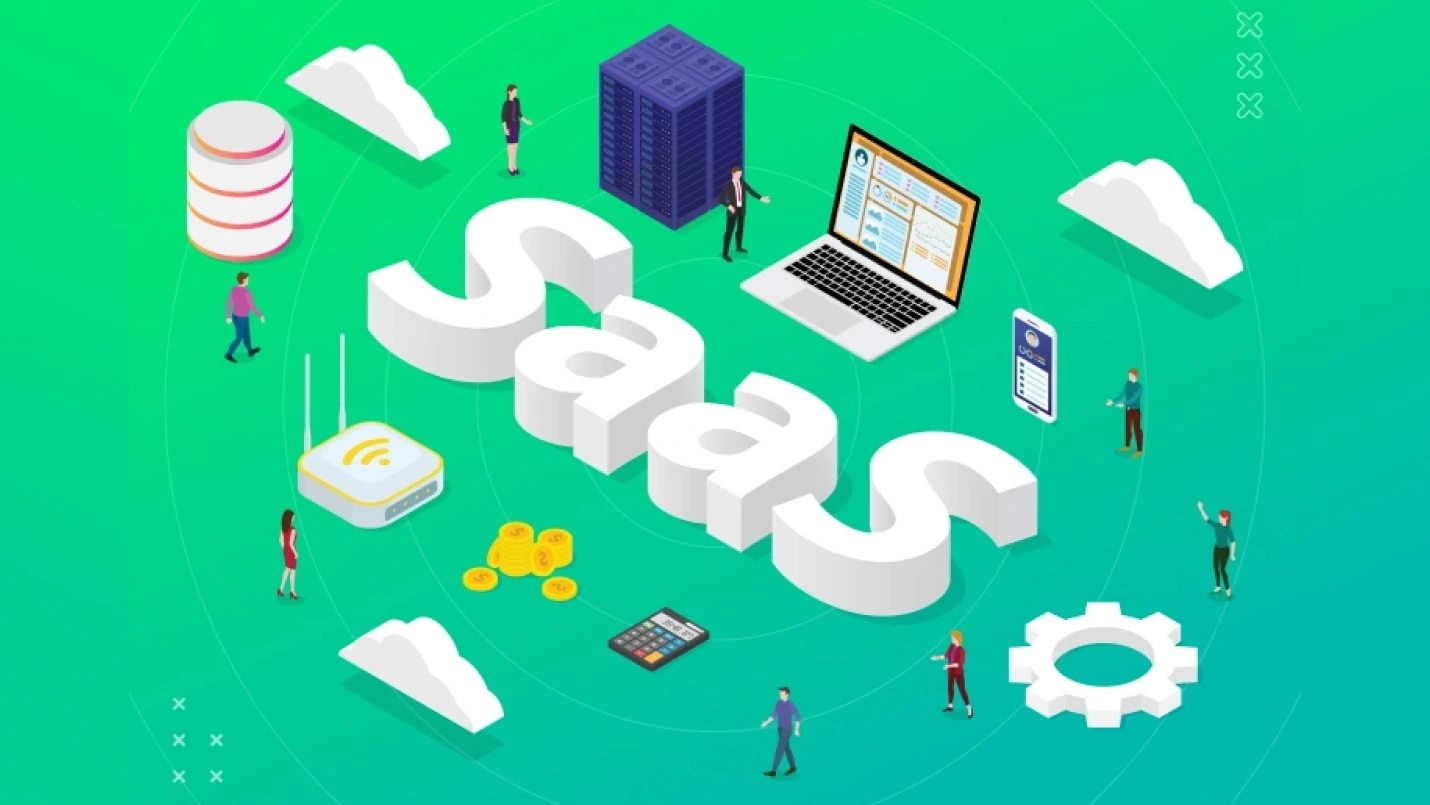Summary: Starting a SaaS company is a lot more challenging than just thinking about it. But we have made it easier for you. Read on to learn how to build a profitable SaaS business from scratch in 10 simple steps.
Software as a Service (SaaS) has proven itself to be a powerful business model since Salesforce made it popular two decades ago. Back in 1999, the thought of offering cloud-based software and charging a regular subscription fee was revolutionary. Today (at the time of publication), Salesforce is worth over $200 billion, which is more than double its value just four years ago.
Are you dreaming about building the next billion-dollar startup? If so, SaaS is a great industry to explore. According to a recent report from Fortune Business Insights, the cloud-based software market is expected to grow 27.5% annually between now and 2028, reaching a total market value of more than $700 billion.
That’s 700 billion reasons to think about creating and selling a SaaS product. This post will give you a few more reasons to start your own SaaS company, along with a thorough overview of how to do it right.
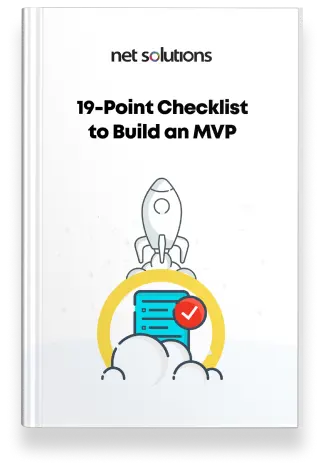
We respect your privacy. Your information is safe.
6 (More) Reasons to Consider Starting a SaaS Company
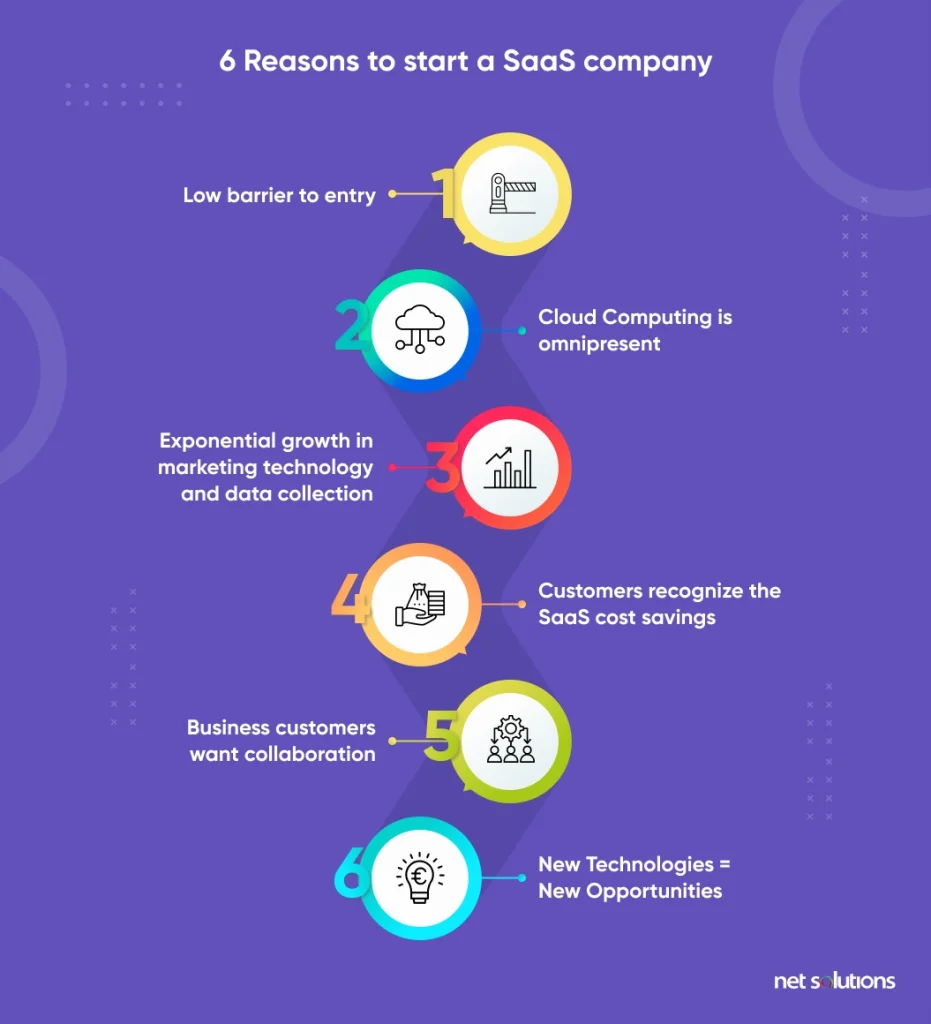
The SaaS model has quite a few advantages for an entrepreneur with a vision. Yes, the potential profits are mind-boggling, but that’s not the only reason to consider starting a SaaS company. Here are six more compelling reasons to explore this business model.
Low Barrier to Entry
Remember when older folks referred to the past as a “simpler” time? Well, in the tech world, life was far more complicated back in the day.
Launching a software platform before cloud computing required hardware, data centers, an exhaustive list of licensing requirements, and other upfront costs. Plus, outsourcing overseas was much more difficult without today’s communications technologies.
We’re not saying launching a SaaS company is dirt cheap these days—being too stingy usually results in low-quality products that struggle to compete. You can, however, start a software company today for substantially less than you would have paid in the past.
Cloud Computing Is Omnipresent
Cloud computing is here to stay, with 94% of all enterprises using the technology according to Google. That’s an impressive statistic, but it doesn’t quite capture the sheer magnitude of “the cloud.”
Google predicts that by 2025, there will be over 100 zettabytes of data stored in the cloud, which is equal to 1 billion terabytes (or 1 trillion gigabytes).
In other words? There’s room for everyone in this growing space.
Exponential Growth in Marketing Technology and Data Collection
Over 100 years ago, the founder of Macy’s famously said: “Half the money I spend on advertising is wasted. The trouble is, I don’t know which half!”
Software as a service entrepreneurs don’t have that problem. Thanks to exponential advances in marketing technology, systems used to track customer behavior grow more powerful year after year. And with the development of Artificial Intelligence (AI) and Machine Learning (ML), everyone from tech giants to small startups will gain access to many of these tools.
That means data-savvy entrepreneurs can use more effective marketing techniques to carve out profitable niches.
Customers Recognize the SaaS Cost Savings
One reason the SaaS model is thriving is that, in the long run, it offers cost savings to most customers—especially in the Business-to-Business (B2B) marketplace.
It may seem counterintuitive at a glance, but it makes sense if you think about it (and crunch the numbers, which enterprise customers do). Simply put, if your infrastructure costs are low as a SaaS company, you can deliver your products at a lower cost. That makes you more competitive, and it makes your B2B clients more profitable.
Business Customers Want Collaboration
SaaS products allow for collaboration in ways that stand-alone software products have always struggled to provide. That makes cloud computing immensely valuable, and it’s a big reason why B2B users will keep paying your subscription fees.
For example, we created the content for this very blog post in a Google doc. Half a dozen people across three different continents contributed to it. Editors, designers, technical reviewers, and proofreaders from around the world seamlessly (and asynchronously) collaborated to make this happen.
Remember when you had to pass an email attachment from one person to another, forcing everyone to work sequentially and wasting countless hours? Nobody wants to go back to that, which is why we’ve all embraced the cloud.
New Technologies = New Opportunities
In Peter Diamandis’ book BOLD: How to Go Big, Create Wealth and Impact the World, the Silicon Valley tech leader and founder of the XPRIZE explores how the exponential growth in technology creates new industries.
One example he gives is the rise of digital photography. When it was first introduced, digital photography was very low-resolution and didn’t “wow” anyone except techies. Eventually, however, this technology reached a tipping point, ultimately giving birth to entirely new industries.
Today, this tech has moved far beyond digital cameras designed to capture memories. It has transformed the way we connect (via video conferencing), close deals (exchanging digitized documents), visit the doctor (virtual visits), and so much more.
As new technology sprouts up around the world, new markets emerge. If you can be one of the first to enter one of these new markets with your SaaS product, your success could be legendary.

We respect your privacy. Your information is safe.
How to Build Your SaaS Business in 10 Steps
Tempting as it may be to put the horse before the car and just start building your product, it’s absolutely vital that you take a methodical approach to launch your SaaS business.
Here at Net Solutions, we’ve worked with countless startups, helping bring their ideas to life through market analysis, design, and development. And one thing successful SaaS companies have in common is that they take a strategic, step-by-step approach to launching their businesses. The following steps will guide you in that process.
Step 1: Discover a Customer Problem
A good product solves a problem. Aside from the Pet Rock, which was popular in the ’70s when the world briefly lost its mind, every product (whether physical or digital) exists to solve a problem.
As a quick experiment, open up your Applications folder on your computer and look at some of the software products you use. Is there a movie/TV show streaming app? That product solves boredom and provides entertainment. Is there some sort of task manager or calendaring app? That product keeps your life from slipping into chaos.
You can discover problems that could benefit from SaaS solutions by:
- Exploring forums like Reddit and Facebook Groups
- Browsing through Quora to see what kinds of questions people are asking
- Paying attention to the conversations in your personal and professional life
- Drawing from your professional or personal experience and considering the struggles you face in your daily life
You can start with the seed of an idea and dig deeper. For example, let’s say you’re interested in a certain type of marketing technology called “heat maps,” which show companies where most of your website visitors click, scroll, and hover their mouse pointers. If you wanted to search for gaps in the current market, you could type into your browser: “why don’t heatmaps…” and it will bring up numerous blog posts and articles telling you where heatmaps fall short.
This exploratory phase is more of an art than a science. You’ll follow numerous paths and have plenty of false starts, but at some point you’ll stumble across a problem that’s potentially worth solving with a SaaS product.
Step 2: Brainstorm a Solution and Identify Your Niche
Okay, so you’ve found a problem that people just might pay you to solve. Now it’s time to brainstorm potential solutions. This may involve:
- Exploring existing solutions and seeing where they fall short
- Delving into communities and asking questions of potential customers
- Having one-on-one discussions with potential customers
Whatever you do, don’t try to be all things to all people. Niches get riches, as they say, so you’ll want to find a specific group of users that is underserved by the current marketplace.
Step 3: Write up a Lean Business Plan
Now it’s time to write up a short, lean business plan. This isn’t going to be a long document that identifies things like budgets and market forecasts. After all, you haven’t even validated your idea at this point.
Your lean business plan should answer the following questions:
- What is your unique value proposition?
- What problem are you attempting to solve?
- What market segment (niche) are you trying to reach?
- Who is your competition?
- Who are your key team members?
- What will your revenue model be?
- What will it cost for you to launch a Minimum Viable Product (MVP)? We’ll talk more about the MVP below.
Step 4: Validate Your SaaS Idea
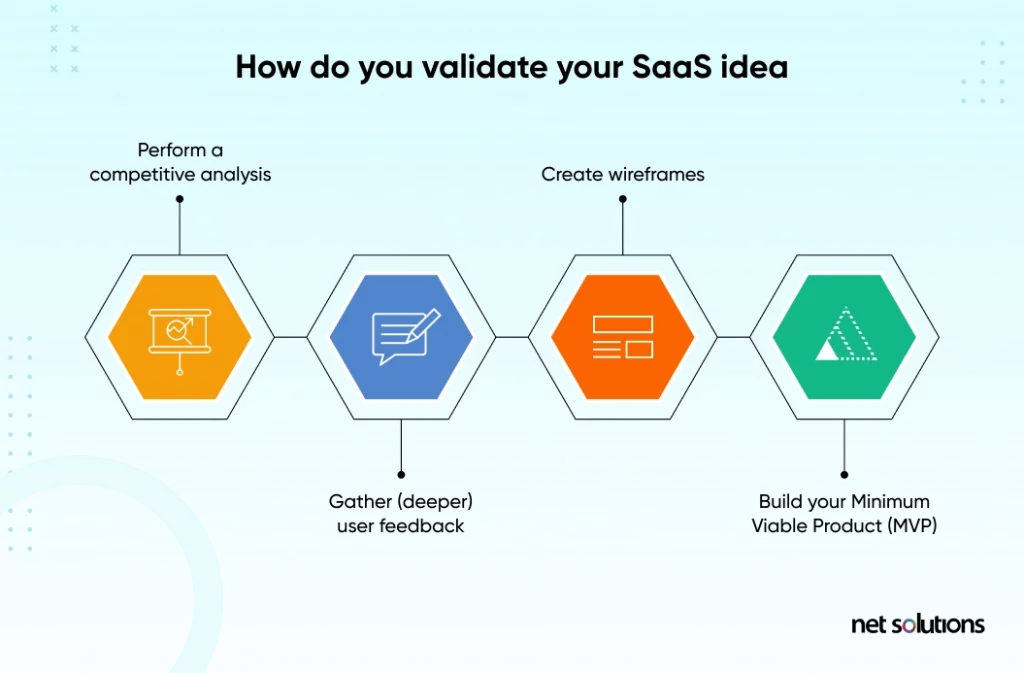
No matter how good your idea seems to be in your own head, if nobody is willing to pay for it, then it’s not worth sinking your time, money, and effort into it. Here’s how you validate your SaaS idea.
- Perform a competitive analysis: Explore similar products on the market, digging deeper than you did in Step 2, to note specific product features and identify where your competitors fall short in serving your niche.
- Gather (deeper) user feedback: Even if you had conversations with potential users or surveyed them during Step 2, it’s time to take a closer look at your potential customers. How do they specifically respond to your proposed solution? What features would they be willing to pay for? You absolutely must build your design around their needs.
- Create wireframes: Your wireframes will likely be simple at this point (what we call low-fidelity wireframes). You might even write them out by hand, describing the user workflow so you understand what happens with every click and every choice they make. You can then return to potential customers to see how they respond to your proposed layout and functionality.
- Build your Minimum Viable Product (MVP): A Minimum Viable Product is a software product that delivers basic, key features—rather than some elaborate vision that hasn’t been tested with real users. The reason companies launch MVPs is because it allows them to get feedback on their product. That first batch of users, who download your beta version, will tell you what they like about your SaaS product, what they dislike, and what they’d like to see in future releases. This model saves resources and ultimately helps you deliver a product that people will pay money to use.
What do you do if you aren’t able to validate your idea? As frustrating as that might be, it’s good to know upfront that your idea doesn’t have legs. That way you can put your time, money, and effort toward something that will sell in the end.
Step 5: Choose Your Revenue Generation Model
There are quite a few different revenue generation models for SaaS products, and they each have their advantages and disadvantages. Keep in mind that you can offer a combination of these. For example, most subscription services offer a yearly option at a discount, and many offer tiered pricing with a free option for new users.
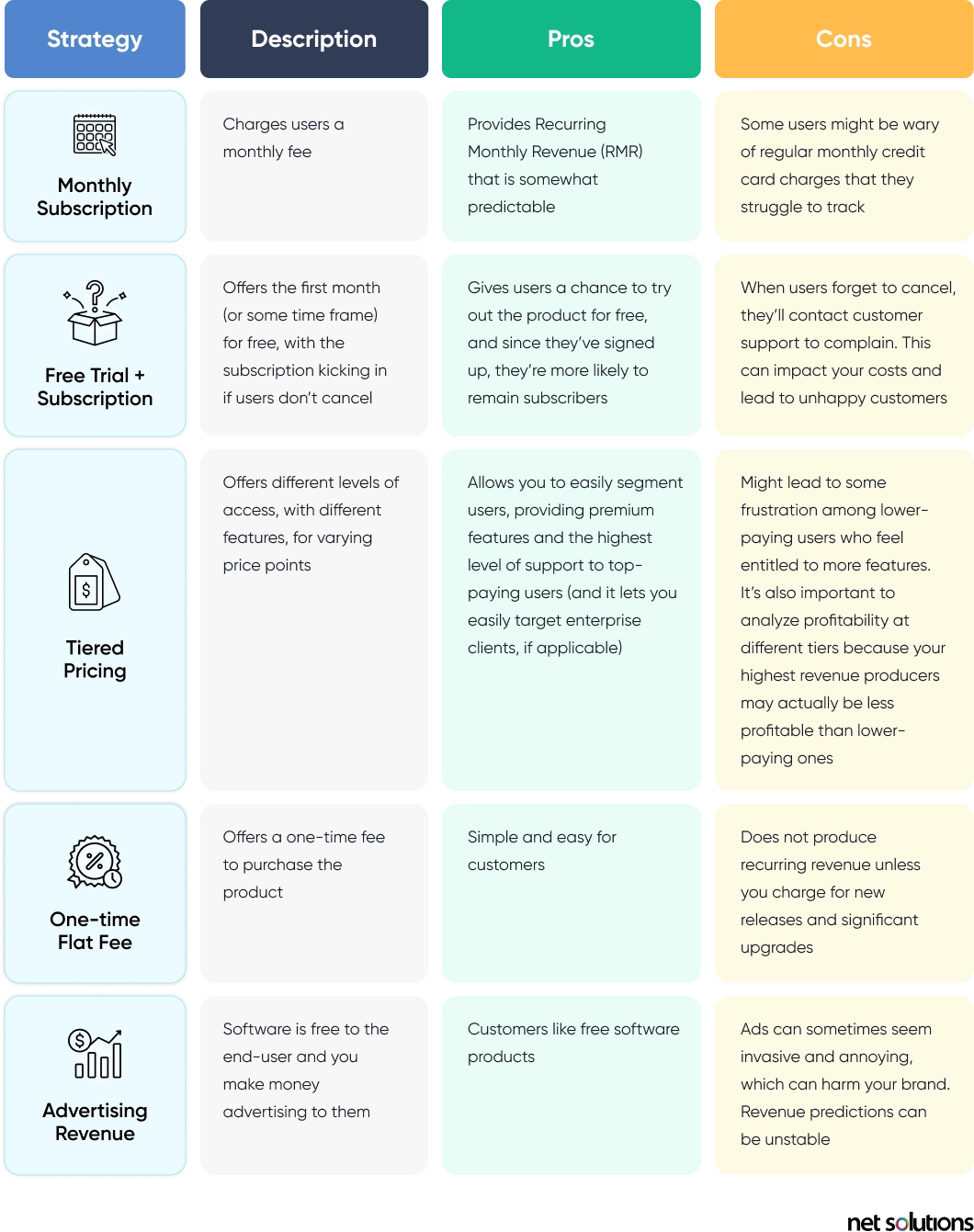
Step 6: Figure Out a Branding Strategy
Your brand is the look, feel, and tone of your company, and it includes everything from your microcopy to the sales copy on your website. For example, at Net Solutions, our tone is down-to-earth, plain-spoken, friendly, not overly formal but still professional. We include some light humor in our blog posts, but we’re mostly focused on delivering practical information to our target audience (people like you).
Compare that to a brand like IBM, which is more serious and corporate. Or compare it with a brand like BuzzFeed, the half-news-half-entertainment site that posts things on their Twitter feed like: “If you think 280 characters is exciting, try reading a book.” That was their way of getting into the retail book market, and while it’s a bit irreverent, their target audience seemed to like it.
In the beginning, you’ll play around with your brand and voice. You’ll probably try some things that don’t work, but you’ll eventually figure out what your audience likes. SaaS companies tend to be casual in their tone, even when they target enterprise clients the way Salesforce and Hubspot do.
Step 7: Make Your Business Legal and Official
Every country has its own rules for setting up a business, and these rules might vary from state to state, province to province, and even city to city. If you’re going to launch a business, you’ll want to know those rules and ensure you’ve set up the best tax structure for your business. That means talking to a qualified accountant in your part of the world.
Step 8: Consider Your Funding Options
In the beginning, almost all SaaS startups are bootstrapped, meaning they’re funded by their founders and sometimes by family and friends of founders. You can also go the crowdfunding route, creating campaigns on GoFundMe, Kickstarter, or Indiegogo to get funding from strangers on the internet. Many startups have bypassed angel investors and avoided costly bootstrapping by creating unique, intriguing campaigns for interesting products.
Once you get buzz around your product (whether you’re bootstrapping or crowdfunding), you might choose to pitch venture capitalists. Angel investors can provide a nice influx of cash in the beginning, and future pitches might result in powerful rounds of funding. Whatever you do, hire a good attorney to look over those terms and conditions before accepting venture capital.
It’s also worth noting that some companies never take venture capital. There are SaaS companies like ClickFunnels that are worth over $100 million, and they haven’t taken a dime in venture funding. As such, the founders remain in complete control of their businesses.
Step 9: Design Your Go-to-Market Strategy
A go-to-market strategy is a fancy way of describing how you plan to reach your customers. Do you plan to use paid advertising on Google, Facebook, or through ad networks? Do you want to build a community to create buzz (something you’ve already done if you’re using crowdfunding)? Do you want to use content marketing to drive traffic to your website and support your SEO efforts? Do you want to engage the power of influencer marketing?
In all likelihood, you’ll use a combination of strategies to win new customers. These strategies will evolve over time as you gain paying customers and learn more about their behaviors and buying habits, so keep an open mind and explore all your options.
Step 10: Establish Metrics to Measure Success
There are plenty of tools available for tracking your performance—both in terms of how customers respond to your products and how effective your marketing efforts turn out to be.
You can use in-app surveys to ask users what they like about your app and what you should improve. You can use on-page surveys to ask users what they think of your website and whether they understand your value proposition, pricing policies, and other factors that pave the way toward more users. You will also want to track things like Cost-per-Acquisition, churn (how many users you lose each month), and other Key Performance Indicators (KPIs).
These metrics will help you improve your products, your marketing efforts, your profits, and your odds of success as a SaaS business.
How to Start Your SaaS Company with No Tech Background
Do you need to be a software developer to start a SaaS company? Absolutely not. Assuming you approach it the right way and partner with the right partners, you can build a SaaS company with zero technical expertise.
Here are a few ways you can approach building a SaaS company as a non-techie:
1. Hire a software development partner
You can hire a company like Net Solutions, whose designers, developers, and business analysts can guide you through each stage. Just be sure to work with someone who will give you an honest, straightforward assessment of your idea’s viability, the costs involved, and delivery time.
Learn more about hiring a development partner whose team can guide you from start to finish.
2. White-label an existing product
There are many software companies that have done all the heavy lifting for you. They’ve created a SaaS product that is fully functional, and for a fee they add your branding to the product. You sell the product under your own brand and run your business without anyone knowing you didn’t build the foundational architecture.
3. Buy a SaaS business
You can buy your own SaaS business and run it yourself. Of course, you’ll still need designers and developers to continually improve the product so it remains competitive. You can also partner or invest in a SaaS business as well.
4. Hire an exceptional CTO
A good Chief Technology Officer (CTO) will have the skillset to translate technical concepts to a non-technical leader. Do your best to learn what you can from a high-level perspective, and you can create a partnership that gives birth to a highly profitable SaaS company.
Five Challenges You Might Face While Building a SaaS Company (and Potential Solutions)
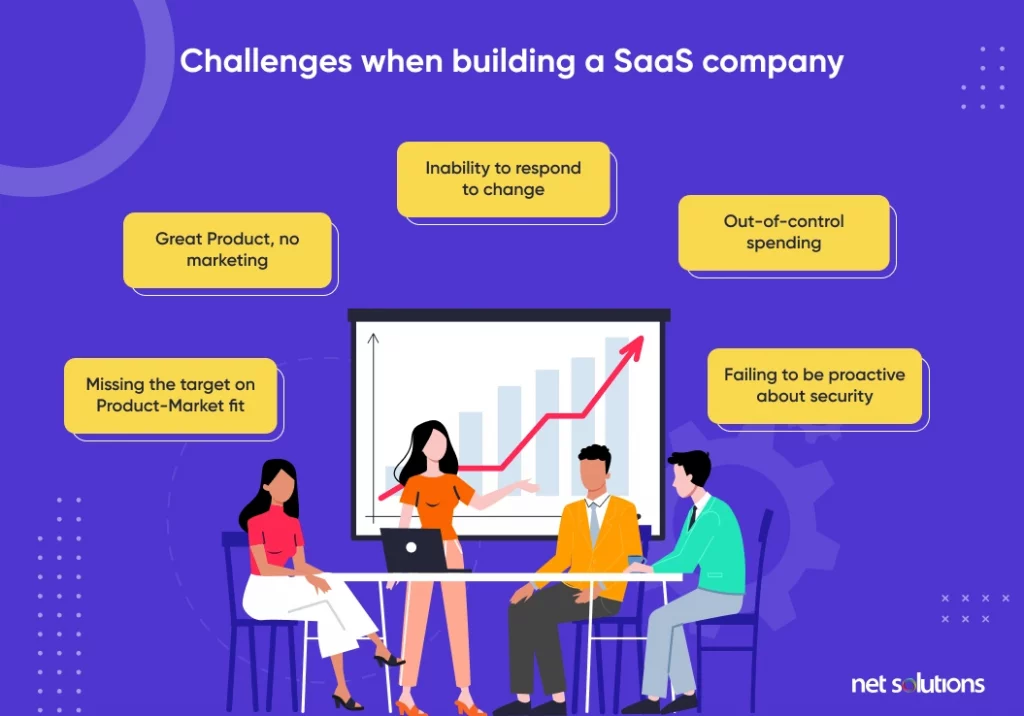
According to Lighter Capital, “An estimated 92% of SaaS companies fail within 3 years despite growth and funding.” We don’t mention this to scare you away from launching a SaaS company, but we want to underscore the importance of building a solid foundation and avoiding common pitfalls.
Here are some of the mistakes founders make and what you can do to avoid those traps.
Mistake #1: Missing the Target on Product-Market Fit
When you create a product that fails to solve the problem it was designed to address, you’ve missed the mark on product-market fit.
Solution
Market research is absolutely essential. Before you start building your SaaS product (even at the wireframe stage), you need to understand your audience, their frustrations, and their drives. Some marketing strategies you might consider include:
- Content marketing to drive traffic to your website and boost your search engine ranking
- Influencer marketing
- General Search Engine Optimization (SEO)
Explore the market, existing competition, and whatever niche you can fill. Figure out what your competitors are doing wrong and address one or more of their shortcomings.
Create a discussion group that includes development teams, stakeholders, and limited test users to validate the need for a specific SaaS product in the market. Finalize the idea that would make a difference after running a vote across the discussion groups.
Mistake #2: Great Product, No Marketing
Many SaaS founders hope that by building an amazing product, users will discover it organically after a Twitter announcement and maybe a press release.
Most of the time, that doesn’t work. Marketing is just as important as having a good product because if nobody knows you exist, nobody will sign up and tell their friends.
Solution
Create a SaaS marketing plan that includes a solid go-to-market strategy. Every go-to-market strategy should be uniquely tailored to your product and the niche you’re trying to reach, and it will evolve in the months and years to come. Your approach will likely include a mix of some of the following techniques:
- Paid advertising
- Social media campaigns
- Influencer marketing
- Content marketing
- Email campaigns
Pricing is also part of the marketing mix, so give a good deal of thought to your pricing strategy and ask for feedback from your users.
Mistake #3: Inability to Respond to Change
The SaaS world is constantly changing. The competitive landscape is always in flux, with new competitors popping up and new technologies altering the marketplace. And that’s not all that’s changing! Sometimes your marketing channels could dry up due to an advertiser’s policy changes or new regulations.
Solution
Running a successful SaaS company means constantly reinventing yourself, adapting your products and your messaging to maintain and expand your market share. It all starts with a Minimum Viable Product, and you’ll incrementally add features to that MVP to improve it based on customer feedback and data.
Develop your SaaS application by following a microservices architecture, (i.e., smaller modules of bigger applications that are loosely coupled). It makes it easier to iterate through the changes, since changes to a particular module won’t affect another module’s functionality. This creates less downtime and fewer frustrated customers.
You’ll also want to maintain a lower amount of cruft in the code (i.e., poorly designed and unnecessarily complicated code segments). The lower the cruft, the quicker it is to identify and fix bugs.
Most importantly, give it time. Overnight success is a myth. Instead, keep working. Launch your product, gather feedback, iterate, and launch a new version. Repeat.
Mistake #4: Out-of-control Spending
As SaaS companies scale, sometimes they place so much emphasis on growth that they lose touch with their burn-rate and available funds. This is especially common before they’ve hired a CFO, whose job it is to monitor and control spending.
Solution
Take an honest look at expenses, especially recurring expenses on other SaaS products. Evaluate how much you use those products and the value they bring. Be sure to have open and honest discussions with your investors as well. That should go without saying, but cautionary tales like Theranos and the Fyre Festival remind us that some founders forget that telling the truth will keep them out of trouble.
Mistake #5: Failing to Be Proactive About Security
Much like finance, security isn’t the most exciting aspect of launching a SaaS company. However, it is absolutely vital because one major security breach could destroy your credibility with the public, with investors, and with your customers. You could also end up legally liable if your security breach arises from negligence.
Solution
Cybersecurity is a vast topic, and we wrote a blog post that provides a primer on website security fundamentals. The bottom line is that you need to do whatever you can to protect your users’ data and your company secrets. There are tried-and-true ways to reduce those risks.
Frequently Asked Questions
Most SaaS founders are hoping to build the next unicorn (a startup valued at $1 billion or more), and you can study successful ones for inspiration. A few SaaS startups to watch in 2022 include: Linktree, Canva, LeadIQ, and Mighty Networks.
The cost to start a SaaS company will vary greatly from one product to the next. According to Forbes, someone could theoretically start a SaaS company (with a very minimal MVP) for as little as $6,000—or as much as a quarter-million dollars for a very robust product. It all depends on what you want the software to do.
Just as with cost, there just isn’t a simple answer to this question because different products do different things. Mark Zuckerberg told Business Insider he developed the first version of Facebook in two weeks, but that’s incredibly fast. Other products can take years to develop, but that’s not common either.
Always let your customers guide you. Solve a problem for them, gather feedback at various stages of design and development, and integrate what you learn into each new product release. Finally, don’t forget to market your product, because software rarely sells itself no matter how good it is.

